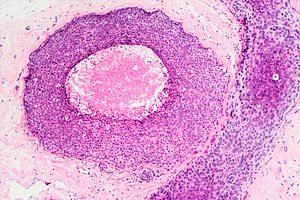
All iLive content is medically reviewed or fact checked to ensure as much factual accuracy as possible.
We have strict sourcing guidelines and only link to reputable media sites, academic research institutions and, whenever possible, medically peer reviewed studies. Note that the numbers in parentheses ([1], [2], etc.) are clickable links to these studies.
If you feel that any of our content is inaccurate, out-of-date, or otherwise questionable, please select it and press Ctrl + Enter.
Breast cancer-like cells found in healthy women
Last reviewed: 02.07.2025

A new study led by researchers at the University of Texas MD Anderson Cancer Center has found that in healthy women, some breast cells that appear normal may contain chromosomal abnormalities commonly associated with invasive breast cancer. The findings challenge traditional ideas about the genetic origins of breast cancer and may impact early detection methods.
A study published in the journal Nature found that at least 3 percent of normal cells from breast tissue from 49 healthy women had gain or loss of chromosomes, a condition known as aneuploidy. These cells accumulate and enlarge with age, raising questions about what counts as "normal" tissue, said principal investigator Nicholas Navin, PhD, chair of systems biology.
These findings pose a challenge for developers of early cancer detection methods, such as molecular diagnostics or analysis of ductal carcinoma in situ (DCIS) samples, as such cells may be mistaken for invasive breast cancer.
"A cancer researcher or oncologist looking at the genomic pattern of these normal cells would classify them as invasive breast cancer," Navin said.
"We've always been taught that normal cells have 23 pairs of chromosomes, but that doesn't seem to be true because every healthy woman analyzed in our study had abnormalities, raising the provocative question of when exactly cancer occurs."
Main results of the study
In the study, the researchers examined breast tissue samples from 49 healthy women who had undergone breast reduction surgery. They compared changes in the number of chromosomes in normal breast tissue with data from clinical studies of breast cancer.
Using single-nucleus sequencing and spatial mapping, the researchers focused on breast epithelial cells, a cell type thought to be the source of cancer. They found that an average of 3.19% of epithelial cells in normal breast tissue were aneuploid, and more than 82.67% of cells showed chromosome copy number changes typical of invasive breast cancer.
Key chromosomal changes:
- Addition of copies of chromosome 1q.
- Loss of chromosomes 10q, 16q and 22.
These changes are common in invasive breast cancer. In addition, women's age was closely associated with the frequency of aneuploid cells and the number of chromosome copy changes: older women had more such changes.
The Importance of Discoveries
The results of the study identified two known breast cell lines, each with unique genetic signatures that are either positive or negative for estrogen receptors (ERs). One cell line had changes characteristic of ER-positive breast cancer, while the other had changes characteristic of ER-negative breast cancer, highlighting their different origins.
Navin noted that this study describes rare aneuploid cells in normal tissue, and more long-term studies are needed to understand what risk factors may cause these cells to become cancerous. Because epithelial cells are found in many organs, these findings may be applicable to other types of cancer.
"This shows that our bodies are imperfect and can make these cells throughout our lives," Navin added.
"This has major implications not only for breast cancer research but for other types of cancer. It doesn't necessarily mean that everyone is walking around with a precancerous condition, but we need to do larger studies to understand these risks."
